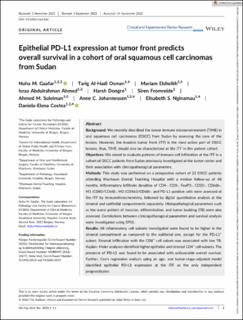| dc.contributor.author | Mohamed, Nuha Mohamed Gaafar | |
| dc.contributor.author | Osman, Tarig Al-Hadi | |
| dc.contributor.author | Elsheikh, Mariam | |
| dc.contributor.author | Alhaj Ahmed, Israa Abdul Rhman Hassaballah | |
| dc.contributor.author | Dongre, Harsh Nitin | |
| dc.contributor.author | Fromreide, Siren | |
| dc.contributor.author | Suleiman, Ahmed M. | |
| dc.contributor.author | Johannessen, Anne Christine | |
| dc.contributor.author | Nginamau, Elisabeth Sivy | |
| dc.contributor.author | Costea, Daniela Elena | |
| dc.date.accessioned | 2022-12-12T09:43:35Z | |
| dc.date.available | 2022-12-12T09:43:35Z | |
| dc.date.created | 2022-10-25T13:17:10Z | |
| dc.date.issued | 2022 | |
| dc.identifier.issn | 2057-4347 | |
| dc.identifier.uri | https://hdl.handle.net/11250/3037178 | |
| dc.description.abstract | Background
We recently described the tumor immune microenvironment (TIME) in oral squamous cell carcinomas (OSCC) from Sudan by assessing the core of the lesions. However, the invasive tumor front (ITF) is the most active part of OSCC lesions; thus, TIME should also be characterized at the ITF in this patient cohort.
Objectives
We aimed to evaluate patterns of immune cell infiltration at the ITF in a cohort of OSCC patients from Sudan previously investigated at the tumor center and their association with clinicopathological parameters.
Methods
This study was performed on a prospective cohort of 22 OSCC patients attending Khartoum Dental Teaching Hospital with a median follow-up of 48 months. Inflammatory infiltrate densities of CD4-, CD8-, FoxP3-, CD20-, CD66b-, M1 (CD80/CD68)-, M2 (CD163/CD68)-, and PD-L1-positive cells were assessed at the ITF by immunohistochemistry, followed by digital quantitative analysis at the stromal and epithelial compartments separately. Histopathological parameters such as the worst pattern of invasion, differentiation, and tumor budding (TB) were also assessed. Correlations between clinicopathological parameters and survival analysis were investigated using SPSS.
Results
All inflammatory cell subsets investigated were found to be higher in the stromal compartment as compared to the epithelial one, except for the PD-L1+ subset. Stromal infiltration with the CD8+ cell subset was associated with low TB. Kaplan–Meier analyses identified higher epithelial and stromal CD4+ cell subsets. The presence of PD-L1 was found to be associated with unfavorable overall survival. Further, Cox's regression analysis using an age- and tumor-stage-adjusted model identified epithelial PD-L1 expression at the ITF as the only independent prognosticator.
Conclusions
Epithelial PD-L1 expression at the ITF was found to be an independent prognostic biomarker for OSCC in a cohort of Sudanese patients. | en_US |
| dc.language.iso | eng | en_US |
| dc.publisher | Wiley | en_US |
| dc.rights | Navngivelse 4.0 Internasjonal | * |
| dc.rights.uri | http://creativecommons.org/licenses/by/4.0/deed.no | * |
| dc.title | Epithelial PD-L1 expression at tumor front predicts overall survival in a cohort of oral squamous cell carcinomas from Sudan | en_US |
| dc.type | Journal article | en_US |
| dc.type | Peer reviewed | en_US |
| dc.description.version | publishedVersion | en_US |
| dc.rights.holder | Copyright 2022 The Author(s) | en_US |
| cristin.ispublished | true | |
| cristin.fulltext | original | |
| cristin.qualitycode | 1 | |
| dc.identifier.doi | 10.1002/cre2.666 | |
| dc.identifier.cristin | 2064857 | |
| dc.source.journal | Clinical and Experimental Dental Research | en_US |
| dc.identifier.citation | Clinical and Experimental Dental Research. 2022. | en_US |

